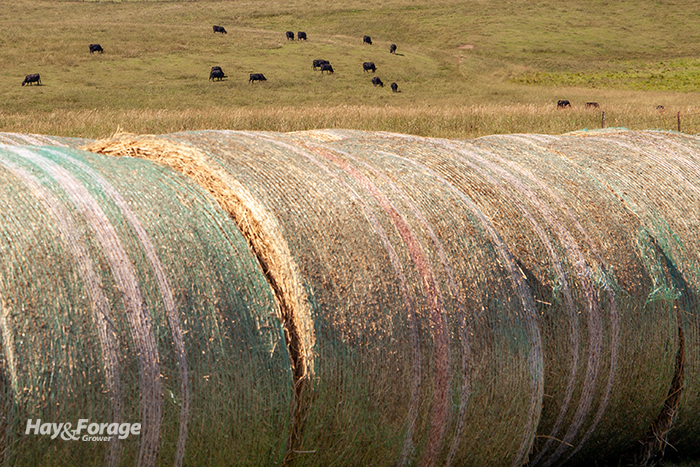
I’m a big believer in no Christmas preparations or activities until after Thanksgiving. So, when it was suggested that I hang the Christmas lights on the house last week, my response was a hard “no.” It’s bad enough that I have to endure Christmas-themed television commercials for three months.
Although it may be too early to get serious about the most cherished of holidays, that’s not the case when it comes to planning for what the beef cow herd is going to eat on Christmas day and beyond. Some of you reading this may still have pasture or cornstalks available on December 25, but many others will be knee deep into the hay-feeding season.
According to University of Nebraska Extension beef cow specialists Rick Rasby and Ben Beckman, getting the most out of stored hay inventories takes some planning and organization; it will also ensure that hay supplies don’t run out before pasture is available in the spring. They shared their comments in a recent BeefWatch newsletter article.
Sample and test
Not all hay is equal in nutritional value, especially with the extreme weather conditions experienced in 2024. The Nebraska specialists, along with every other beef cow specialist in the U.S., highly recommend that hay be sampled and tested by lot. A lot is defined as hay harvested at a similar time, from the same plant type and growth stage, and from the same field.
“For most hays, 20 subsamples should be taken per lot and then mixed before the sample bag is filled and submitted to the laboratory,” the beef specialists recommend. “This helps capture variation in the hay. When sampling, try to take samples at random from bales. Don’t seek out good spots or avoid bad ones, as this can skew results providing an inaccurate assessment of the hay quality,” they add.
Requesting a near infrared spectroscopy (NIRS) analysis is generally sufficient and cost effective. Rasby and Beckman also note that it is important to accurately identify the type of hay sampled (for example, alfalfa, summer annual, prairie hay, bromegrass).
“Most common hays have a robust NIRS database for labs to pull from, but complex mixtures or rare hay types may still be best analyzed using traditional wet chemistry,” the specialists assert.
At a minimum, request a test that provides moisture and crude protein content along with a calculated total digestible nutrients (TDN) value. An accurate assessment of minerals will require a wet chemistry analysis. Any summer annual crops should also be tested for nitrates.
Know what you have
With forage test results in hand, hay then needs to be inventoried. First, count bales by type (for example, alfalfa, grass, or summer annual), then inventory each hay type by quality, assigning bales in high, medium, and low categories based on crude protein and TDN values.
Take a weight of each hay type by quality and calculate total pounds of each type. This will help determine the number of feeding days for each hay type and quality. “Cows will eat more of the high-quality hay compared to the moderate- and low-quality hay because it is easier to digest,” the authors note.
Cows consume between 2% and 2.5% of their body weight on a dry matter basis. When determining how much hay will be needed, Rasby and Beckman remind cow owners to account for storage losses (10% to 25%) and feeding losses (10%). “It is important to store hays in such a way to reduce storage losses,” they assert. “Store big round bales on the round side with space between them and not in low places where water settles. Also, limit or control the growth of weeds around the bales.”
To determine hay needs, the beef specialists offer an example calculation. If cows, on average, weigh 1,200 pounds and the hay quality is moderate to high, each cow will eat 30 pounds per day. When accounting for feeding losses of 10%, this calculates to 33 pounds per head per day on a dry matter basis.
To determine the amount needed on an “as-fed” basis, look at the hay analysis to get the dry matter content. If the hay is 85% dry matter, divide 33 pounds per head per day by 0.85 to determine pounds per head per day “as-fed.” For this example, the amount is 39 pounds per head per day. If storage losses are 15%, you will need to budget 45 pounds per head per day.
One more step
With an inventory complete, it will then be convenient to organize the stackyard by hay type and forage quality. Stack hay of similar type and quality together. Sort any high-nitrate forage into its own pile, as these will need to be diluted with other hays to be fed at a safe level.
“Organize the bales in the stackyard so that you can easily get to each hay quality and type,” the specialists recommend. “Work with your extension educator or nutritionist to determine when and what to supplement when the hay doesn’t meet the cow’s nutrient requirements based on her stage of gestation or lactation.”
Getting ready for the hay-feeding season takes some effort, but the payback can be tremendous from a production standpoint. It may also prevent you from scrambling to purchase hay next spring.

